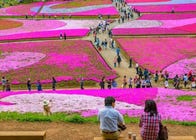
How have sakura, or cherry blossoms, become the unofficial symbol of Japanese nature? Sakura are in bloom for only a couple of weeks each spring, yet there's always a flurry of picnicking and photo-snapping activity surrounding the season.
Once the buds open, there's an explosive chain reaction resulting in a beautiful display of pale pink petals across the parks and streets of Japan which soon flutter to the ground in a grand finale known as sakura fubuki - sakura snow. A trip to see the cherry blossoms is the pinnacle of Japanese nature in all its glory.
We've put together a comprehensive list of weird and wonderful facts about cherry blossom trees to help you enjoy the viewing of sakura this year!
1. What is the history of sakura in Japan?

Our first of several facts about cherry blossom trees is that according to the traditional Japanese calendar, spring officially starts on February 4, the day known as risshun. Kicking off spring in Japan is the February bloom of Japanese plum blossoms.
This is followed by the early spring celebration of Hina Matsuri on March 3 that wishes health and happiness for girls. After the ornamental dolls of Hina Matsuri are put away, it’s only a matter of time until the cherry blossoms are in bloom.
As spring’s premier event, it’s no surprise that talk of cherry blossoms dominates the conversation in Japan. It’s no exaggeration to say that all of Japan is glued to their TV screen anxiously awaiting updates on the weather forecast.
Will there be sunny skies for this year’s cherry blossom viewing party? Exactly when will the cherry blossoms begin their bloom? Will spring showers put a premature end to cherry blossom festivities? The following are some of the other big questions asked about cherry blossoms in Japan!
2. What is so special about cherry blossom trees?

Cherry blossoms hold such appeal in Japanese culture, because of what they symbolize: a time of renewal, the fleeting nature of existence, the impermanence of beauty, the essence of the moment, and much more. All of these concepts have been cherished in Japan since the days of antiquity.
Even by the Heian Period (794 – 1185), hanami, or "flower watching" parties for the nobility, were almost exclusively reserved for cherry blossoms. And though nowadays people flock to parks and gardens throughout the year to admire Japan's seasonal flora, no other plant has managed to etch itself onto the national psyche in quite the same way as the ephemeral sakura.
3. Why are there so many cherry trees in Japan?

Another of our cherry blossom facts is that there are many species of cherry – in Tokyo's Ueno Park alone, there are over 50 varieties – some of which have been cultivated through cross-breeding. These efforts took off in the 14th century where they became cultivated as an ornamental flower.
In the mid-19th century, a variety of cherry blossom known Somei-yoshino (Prunus x yedoensis) was first introduced in Japan. From the late 19th century onward, its cultivation spread across the country, resulting in it becoming the most abundant species of cherry tree.
4. Do cherry blossoms represent love?

In China, where there is also an abundance of cherry blossom trees, sakura symbolizes love and femininity. While this meaning hasn't translated directly to Japan, the cherry tree stands for love in more subtle ways: love for the life you have, love for the brief time that you are privileged to have it, and love for being able to appreciate such moments of beauty.
5. Are cherry blossoms good luck?

Like many recurring elements in Japanese art and culture, cherry blossoms also augur good fortune. Again, the flower's good luck mythology is somewhat more subtle.
In central Japan (including in Tokyo, Kyoto and Osaka), cherry blossoms tend to bloom as the end of March segues into April; this coincides with the end of the Japanese fiscal calendar when school years end and re-begin, or when Japanese corporate workers say sayonara to one department of their company and join another.
As the cherry blossom bursts forth with gusto and style during this period it represents a beacon of hope for students and workers for the year ahead, allowing them to look forward with optimism. Cherry blossom tea – which we'll take more about later – may also be served at events and weddings as an auspicious token for the newlyweds or celebrants.
6. What is the significance of cherry blossoms in Japanese culture?
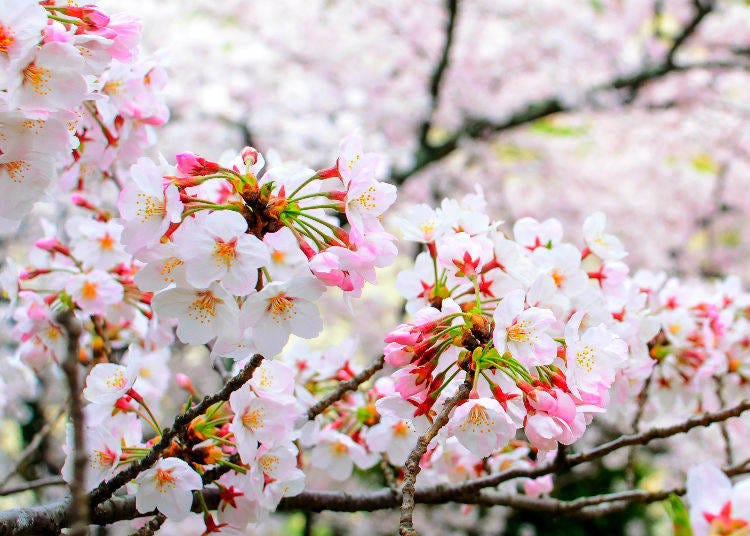
Around February each year, shops all around Japan stock their shelves with sakura-themed items, snacks, and dishes. This is way before the first flowers open, mind you, but the mood is set well in advance.
Every year, this cherry blossom market grows larger and the range of products and food centered on the flowers increase. Especially dessert creations and sweets are plentifully available during March and April when Japan actually experiences the beautiful cherry blossom.
But as we have already alluded to, the routes of the cherry blossom in Japan runs yet much deeper than mere convenience store crazes. Their fleeting beauty illustrates all too perfectly that nothing in this world is permanent, everything passes away at some point.
A sad but beautiful admiration for this impermanence has been an important part of the Japanese mindset since ancient times. In Japanese, it's called "mono no aware." This mindset can be found in the smallest things of Japanese daily life.
Another common theme of Japanese cultural trappings, is their inextricable links with food. Fans of manga and anime might know the expression "hana yori dango (food over flowers)," which simply means to be present in the moment by pairing nature's beauty with equally appealing and delicious food. There are many ways to enjoy the beauty of cherry blossoms but they nearly always include alcohol and food!
This is the main event on Japan's social calendar. Plenty of Japanese look forward to gathering with their friends, family, acquaintances, and future classmates and coworkers.
7. What does a cherry blossom tattoo mean?

Cherry blossom tattoos, apart from being stunning and emphasizing the delicate nature of human skin, symbolize many of the same concepts as their real-life counterparts.
Ironically, though we tend to use the word "permanent" for tattoos, sakura ink speaks to feelings of impermanence, the transience of life.
Though tattoos have long been stigmatized in Japan – partly because of their links to the yakuza crime syndicate – cherry blossom tattoos can also be connected to the philosophies of Buddhism and Shintoism, the nation's primary religions.
Celebrating the moments that make up a lifetime and the beauty of nature are core precepts of these religions; both of which are reflected in the Shinto and Buddhist faiths.
8. Are there cherry blossoms in Tokyo?
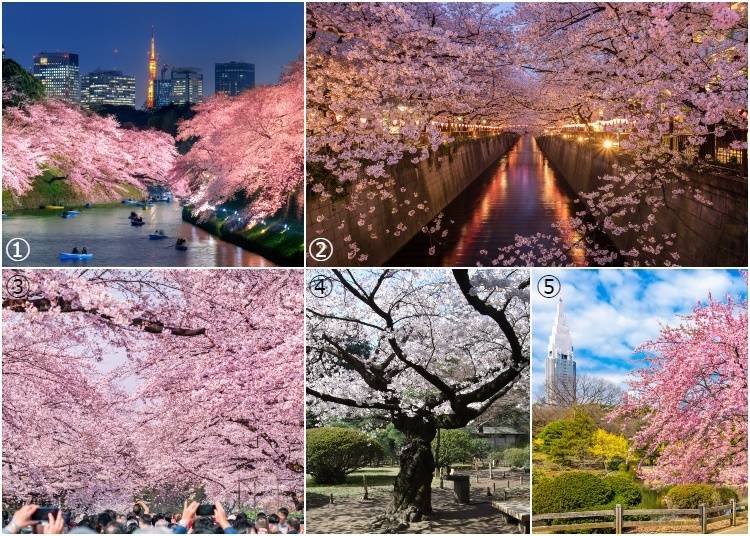
People don't typically think of Tokyo as a green city, but the Japanese capital is peppered with large parks and beautiful botanical gardens amid its dense urban sprawl. And you would be hard pushed to find a greenspace in the city that doesn't bear at least one – or several – sakura trees.
Due to the sheer magnitude of cherry blossom trees that bloom across the major parks of Tokyo, these areas can get busy. But if you visit during full bloom, the floral sights are unforgettable.
Ueno Park, and its accompanying Shinobazu Pond, is arguably Tokyo's number one haunt for cherry blossom viewing. The major downtown parks of Yoyogi Park and Shinjuku Gyoen National Garden, located in Shibuya and Shinjuku respectively, are equally not be missed.
The mystical weeping cherry of Rikugien Garden in northern Tokyo, the legendary sakura-lined Meguro River, and Chidorigafuchi Moat where cherry blossoms hang drunkenly over a placid moat are also among the top viewing spots in the capital – plus each area's sakura are illuminated after nightfall!
9. What should I wear to see cherry blossoms in Japan?
Although the cherry blossoms bloom in spring, you should dress in layers, especially when going out at night. The sun's rays certainly feel nice in the daytime, but once the sun goes down, the chill sets in!
10. When is the best time for cherry blossoms in Japan?

This is a commonly asked question and another of our essential facts about cherry blossom trees! Starting around March 20, the cherry blossom trees in the southern region of Japan (Kyushu) begin to bloom. Next, is the island region of Shikoku, Chugoku (Hiroshima/Okayama), the Kinki/Kansai Region (Kyoto/Osaka), and Tokai (Nagoya).
Then, the cherry blossom front reaches the Kanto (Tokyo) region by the end of March. It then moves upward to Hokuriku (Kanazawa) and Tohoku (Sendai), reaching Nagano in mid-April and the northern island of Hokkaido at the start of May.
In the Kanto region, buds turn yellow-green and open in mid-March. Gradually they become pink. On average you can expect the cherry blossoms to be in full bloom around five days after the Japan Meteorological Agency (JMA) announces that the buds have opened. However, if there is a cold snap the flowers will reach peak bloom ten days after the JMA announcement.
You have a two-week window starting from when the buds bloom to when they start to wither. This is all of course dependent upon factors such as wind and rain.
There are several terms in the Japanese language used to describe the trees when they are three-quarters in bloom and nearly in bloom. It is around this time that the petals take on their signature pink color. It is also around this time where you can see both the cherry blossom buds and blossoms at the same time.
11. How long do the cherry blossoms last in Japan?
Full bloom (mankai) typically occurs within a week after the first opening of cherry blossoms (kaika); you can expect to enjoy the cherry blossoms at peak bloom for about one week.
12. Can I still enjoy cherry blossoms in Japan ever after peak bloom?

You will see hazakura, cherry blossom trees whose blossoms have been replaced with fresh green leaves, anywhere from April to May. The contrast between the dainty pale pink petals and the vibrant green leaves is nature’s signal for summer to make its entrance. When you see hazakura, you’re witnessing the change in seasons, a sayonara to spring.
13. Any tips for seeing cherry blossoms at night in Japan?

The best way to delight in the full bloom of cherry blossoms is under the moonlight. The moonlight casts a filter over the blossoms, creating a dreamy, romantic mood.
In Tokyo, try to visit a popular spot like Roppongi or Rikugien in the daytime then again at night to marvel in the change in scenery. Accent your nighttime viewing with a bottle of your favorite beverage.
14. Where are cherry blossom trees found in Japan? What can I expect to see during cherry blossom season?

It’s said that Japan has 600 species of cherry blossom trees. Around 80% of them are somei-yoshino. When cherry blossoms reach peak bloom depends on their region and species. For example, some varieties in Okinawa bloom as early as January, while trees in other areas of Japan don’t bloom until mid-May. Furthermore, trees in Hokkaido stay in bloom much longer compared to other regions.
There are also several species of cherry blossom trees that bloom even in the winter. You can see these trees in bloom twice a year, once in April and again from October to January.
While cherry blossoms are closely associated with spring, there are times where unusual weather patterns will cause them to bloom in autumn or winter. Cherry blossoms prepare for their spring debut in the winter. But if the mechanism that controls their bloom is interrupted they will mistake the warm temperature for spring and open prematurely.
When cherry blossoms bloom depends heavily on location and temperature, so it's a good idea to keep an eye on the forecast.
15. What are those birds in Japanese cherry blossom trees?

Birds play a vital role in pollinating flowers and trees. Let's dig deeper into another of our cherry blossom facts and take a look at the species you're likely to find among the cherry blossoms in Japan.
The nectar of cherry blossoms is deep at the base of the petals. Only birds with long thin beaks can reach the nectar. Therefore, you're likely to see the Japanese white-eye and brown-eared bulbul nestled among the cherry blossoms. Birds like the Japanese tit and Eurasian tree sparrow have short, stout beaks so they need to tear at the petals to reach the nectar. When you see petals on the ground, it's likely the work of those two.
Among the many varieties of cherry blossoms trees, birds are found on Somei-yoshino and other single petal flower varieties because they have more nectar.
A. Japanese white-eye
A bird with a sweet tooth, the Japanese white-eye is attracted to nectar and fruit. You can easily spot them thanks to their yellowish-green feathers and white ring around their eye. The Japanese white eye is frequently mistaken for the Japanese bush warbler, but it takes a keen eye and ear to spot the difference.
B. Brown-eared bulbul
High in the trees chirping cheerily is the brown-eared bulbul. You can often find them drinking the nectar upside down.
C. Japanese tit
You'll instantly recognize the Japanese tit thanks to the bold black line running down its chest. It chirps as if it's urging spring to begin.
D. Sparrow
The urban-dwelling sparrow is responsible for picking apart the cherry blossom in search for nectar. It's believed that the sparrow drinks the nectar of cherry blossom because their food source is diminishing.
16. Do cherry blossoms smell?

In early spring, you’ll see cherry blossom-flavored drinks, sweets, and snacks all over Japan’s shops and department stores—but do Japanese cherry blossoms even have a smell?
Generally speaking, the scent of sakura is subtle and delicate, including the flowers of Somei Yoshino, the variety that makes up 80% of Japan’s cherry blossom trees. It's curious among cherry blossom facts, but even if you hold a flower right under your nose, there will only be the tiniest hint of a scent. Most people recognize the scent and taste of cherry blossoms as their salted leaves and petals, or the aromatic traditional sweet called sakuramochi.
For salted cherry blossoms—a recipe that has been around for centuries—people generally use “double cherry blossoms” of the Fugenzo or Kanzan varieties and pickle them with salt or plum vinegar. The leaves of sakura trees are pickled in the same way, coming from the Oshima cherry variety. This pickling brings out the plants’ coumarin, a fragrant organic chemical that gives the cherry blossoms a wonderful aroma.
For a genuine whiff of the cherry blossom scent, pour hot water over the flower. The rising steam carries an elegant and sweet aroma, which is the natural scent of sakura.
17. What do cherry blossoms taste like?

Much like its smell, and like some of its symbolic meanings, the taste of a cherry blossom petal is subtle. Mildly floral, ever-so-slightly bitter, and a touch of earthiness, the flavor of sakura works as a nice accompaniment to other more imposing flavors.
It pairs well with sugar in sakura-flavored sweets, works beautifully as an infusion for floral teas, and can even be used as an ingredient in seasonal cocktails.
Let's take a look at some of its most common usages in Japanese cuisine:
A. Sakura Onigiri
By pickling both the leaves of Japanese cherry trees and the flowers, they're left intact. Especially the flowers boast a beautiful, vivid pink color and are used as toppings for tea called sakurayu, sakura anpan (bean paste-filled sweet rolls), or sakura onigiri (rice balls).
B. Sakuramochi
The most famous dish made with these pickled leaves and flowers is sakuramochi. The rice cake is wrapped in the leaf, while the flower is often—but not always—used as a topping.
Sakuramochi can be enjoyed in two different ways. A lot of people eat it as it is, with the pickled leaf wrapped around the rice cake, while others wait until the fragrance of the leaf has soaked the rice cake and then eat them separately from each other.
C. Sakurayu
Sakurayu is a cherry blossom tea in which hot water is poured over the pickled flower. This tea is somewhat of a lucky charm and often served at weddings or engagements instead of the usual green tea. Regardless of the season, it is commonly enjoyed for celebratory occasions.
D. Sakura anpan
Sakura anpan is a spring-tastic twist on the regular sweet roll with bean paste. One of the most famous shops when it comes to sakura anpan is Ginza Kimuraya. After presenting a bread specialty called sakadane anpan sakura to Emperor Meiji, it became a craze all around Japan. The sweet, flavorful bean paste is the heart of this snack, embraced by fluffy bread and topped with a salted cherry blossom that provides a hint of salt.
18. What’s the difference between sakuramochi from Kansai and Kanto?

Sakuramochi is a seasonal word to express spring. It also is a sweet to celebrate the Doll’s Festival (Hinamatsuri) on March 3 and one of Japan’s most beloved spring desserts.
However, if you did an image search of “sakuramochi,” you’ll come across at least two kinds that look rather different from each other. This is because the shape of the sakuramochi differs by region.
The sakuramochi of the Kanto region, meaning around Tokyo, is called “chomeiji” and is shaped a bit like a crêpe, with sweet bean paste wrapped in a bread-like baked dough. It is named after the temple where Tokyo’s own sakuramochi were first sold. Its creator collected the leaves from the banks of the nearby Sumida River, preserved them, and made the now famous mochi variety.
The people of Edo loved it and even today, you can enjoy the traditional sweet for around 200 yen per mochi (tax included). For 100 yen extra, sit down in the shop and enjoy it with a cup of green tea.
Meanwhile, Kansai’s sakuramochi is called “domyoji” and features a round bun shape. It is made from a rice cake powder called domyoji-ko and filled with sweet bean paste. As its name suggests, the mochi was first created at Osaka’s Domyoji Temple.
Domyoji-ko is a type of rice that is first cooked and then dried, before being pounded into a very coarse powder. It boasts a history of over 1,000 years and was first created as army provision that was easy to carry and easy to store. These kinds of sakuramochi can be found for about 150 yen at basically all convenience stores throughout the country.
During spring, you’ll also find all sorts of sakuramochi varieties in the basement floors of Japanese department stores. They tend to be a bit more expensive than the convenience store choices, at about 200 to 300 yen.
A lot of famous confectionery stores offer their creations there and comparing the different creations is a fun and gourmet-centric pastime during spring! The main question is, however: chomeiji or domyoji, which one is your favorite?
19. Why are Sakura Cherry Blossom songs such tear-jerkers?

As already mentioned, the fleeting cherry blossom has inspired artists since ancient times. One trend that you will notice when it comes to songs that have “sakura” in their title is that a lot of them are bittersweet or downright sad and dramatic—why is that?
The reason for that actually does not lie with the short life of the flowers. Throughout Japan, the sakura trees blossom between March and April, which is the season for graduations and entrance ceremonies at Japanese schools.
This also means a lot of changes, a lot of goodbyes, and a lot of life-altering decisions. Where to go next, what to do from here? What will the future hold? It’s a time during which people leave the environment they’ve grown up in, parting with long friends and even lovers.
To say it briefly, it’s an emotionally turbulent time. Because of this amalgamation of complicated feelings, songs that tug at your heartstrings with dramatic and emotional lyrics and melodies are generally called “sakura songs.”
Some name the cherry blossom in their title and some don’t, but the trend definitely goes towards calling a springtime melody “sakura something-something.”
One of Japan’s most famous songs is called “sakura sakura,” initially composed in the late Edo period as a practice song for the koto, a traditional string instrument. Its current lyrics were written in the Meiji period, which is also when the song has become so majorly popular that there’s not a single person in Japan who doesn’t know it.
Nowadays, various artists release such a sakura song every spring season.
Some of the best-selling J-Pop examples of such sakura songs are:
1. “Sakurazaka” by Masaharu Fukuyama
2. “Sakura no ki ni narou” (Let’s become a sakura tree) by AKB48
3. “Sakura” by Naotaru Moriyama
4. “Sakura” by Ketsumeishi
5. “Sakura Drops” by Hikaru Utada.
All of them are often sung or played at graduation parties or even when parting with a love interest. Even if you don’t understand the Japanese lyrics, we encourage you to give those songs a listen—can you feel your heartstrings being pulled at?
20. Why are so many things called “Sakura” in Japanese when they have nothing to do with cherry blossoms?

The Japanese language is filled with words and expressions featuring “sakura,” even if they seemingly have nothing to do with actual cherry blossoms. That is because the cherry blossom image is a very familiar one for Japanese people, so even things slightly resembling the flowers in one way or another are often named after the blossoms. For tourists, this may be especially confusing, as a lot of things really look nothing like the flowers at first glance! Let’s take a look at some of the most common words.
You’ll notice that a lot of the things introduced either boast a resemblance to the famous cherry blossoms in color, shape, or both – sometimes it may take a bit of imagination, but for the Japanese name givers, the resemblance is obvious!

Shibazakura – Pink Moss Phlox
Also called “hanatsume kusa.” The shape of this flower resembles the cherry blossom and it blooms either in a vivid pink or light purple. It covers the ground densely, forming a floral carpet that is absolutely breathtaking.
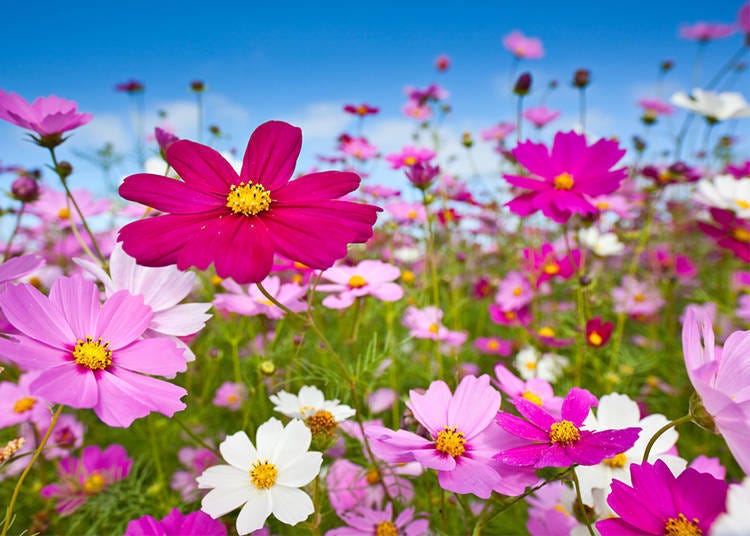
Akizakura – Cosmos Flowers
The Cosmos, a flower that blooms in autumn. The kanji for “akizakura” can also be read as “kosumosu,” making the phrase a phonetic equivalent to the flower’s actual name. The spelling was made popular by the song “Kosumosu” by Momoe Yamaguchi in 1997.

Sakuragai – A Type of Wedge Shell
These clams are named because of their pale pink color, making them look like cherry blossom petals.

Sakura ebi – Sakura Shrimp
These little shrimps have a semi-translucent body that shines in a subtle pink, resembling the color of Japan’s famous cherry blossoms.
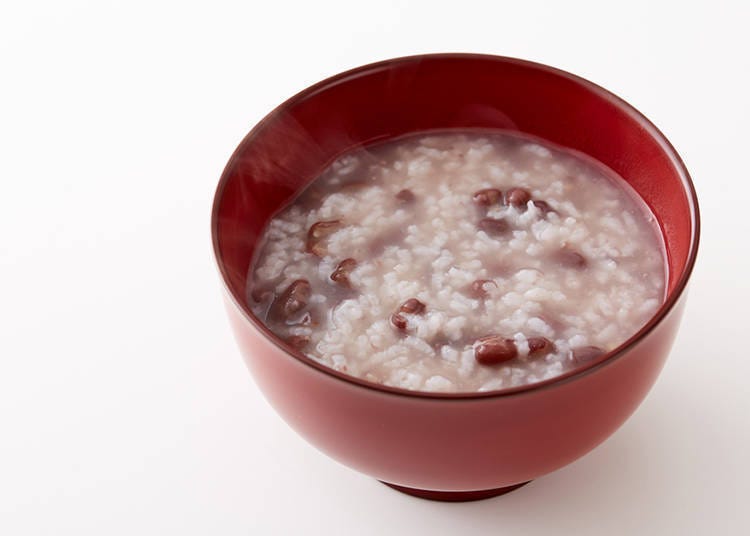
Sakuragayu – Red Bean Porridge
Sakuragayu is a porridge made with sweet red beans and rice. Traditionally, it is eaten during New Year’s, on January 15th to be precise, to purge and ward off evil and disaster.

Sakurani – Cooked Octopus Legs
This is a dish of octopus legs being cooked until soft with sake, soy sauce, mirin, and sugar. The finished dish is of a pink color.
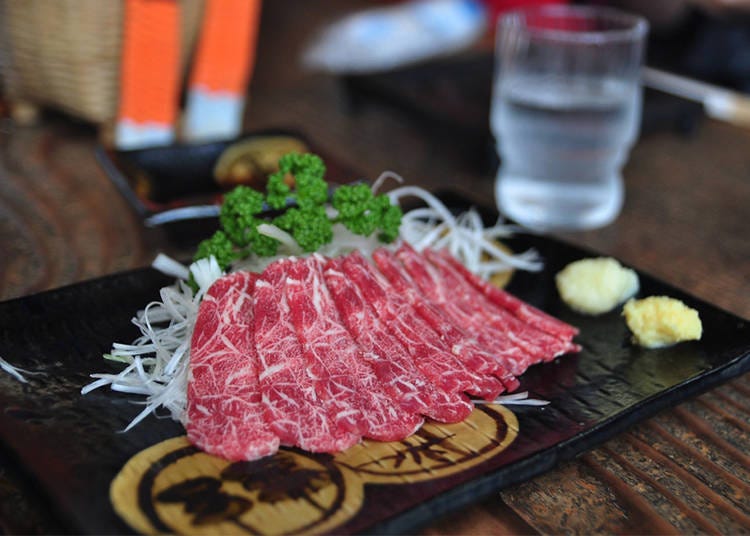
Sakuraniku & Sakura nabe – Horse Meat and Horse Hot Pot
This might be one of the weirdest sakura names. Sakuraniku describes horsemeat, while sakuranabe stands for a hot pot made with said horse meat. Incidentally, boar meat is called “peony meat,” while venison is also called “autumn leaf meat,” literally translated. There are various theories on how this name came to pass, with the most prominent one saying that these names were invented to conceal where the meat came from, as the consumption of game was forbidden during the Edo period.
Sakura, Spelled in Katakana – Fake Buyer, Hired Applauder
If “sakura” is spelled not in kanji characters (桜) but instead in katakana (サクラ), the syllabary used to spell words with a foreign origin, it can also refer to a fake buyer. That’s a person at, for example, a market stall, getting all excited about the wares to attract other customers. On TV, you’d also call someone hired to applaud or create excitement for a performer or act.
Cherry blossoms aren’t only a beautiful phenomenon in spring, but the culture and philosophy around them is a major part of Japanese daily life as well. From the image of the filigree flowers to their complex and bittersweet meaning, you’ll stumble across “sakura” a lot more than you might expect!
*Prices and options mentioned are subject to change.
*Unless stated otherwise, all prices include tax.
Popular Tours & Activitiess
Recommended places for you
-

ISHIDAYA Hanare
Yakiniku
Kobe, Sannomiya, Kitano
-
Appealing

Rukku and Uohei
Izakaya
Sapporo / Chitose
-

Kanzenkoshitsuyakinikutabehodai Gyugyu Paradise Sannomiya
Yakiniku
Kobe, Sannomiya, Kitano
-

Kambei Sannomiyahonten
Yakiniku
Kobe, Sannomiya, Kitano
-

Jukuseiniku-to Namamottsuarera Nikubaru Italian Nikutaria Sannomiya
Izakaya
Kobe, Sannomiya, Kitano
-
Goods

Yoshida Gennojo-Roho Kyoto Buddhist Altars
Gift Shops
Nijo Castle, Kyoto Imperial Palace
-

Sapporo Cherry Blossom Guide: Best Time & Top Spots for Sakura Viewing
by: Andy Cheng
-

10 Beautiful Places in Miyagi Prefecture to See the Cherry Blossoms in 2025
by: Alexander Litz
-

Top 10 Places in Iwate to See the Cherry Blossoms in 2025
by: Alexander Litz
-

Seafood Bowls and More at the Shiogama Seafood Wholesale Market!
-

3 Famous Ramen Shops in Yamagata - Japan's "Ramen Prefecture"!
-

3 Best Hotels in Kobe, Japan with Amazing Views of Kobe Bay!
- #best sushi japan
- #what to do in odaiba
- #what to bring to japan
- #new years in tokyo
- #best ramen japan
- #what to buy in ameyoko
- #japanese nail trends
- #things to do japan
- #onsen tattoo friendly tokyo
- #daiso
- #best coffee japan
- #best japanese soft drinks
- #best yakiniku japan
- #japanese fashion culture
- #japanese convenience store snacks















